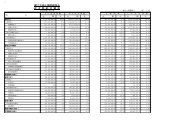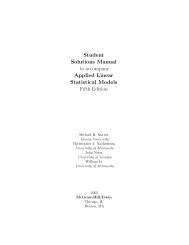Journal of Film Preservation - FIAF
Journal of Film Preservation - FIAF
Journal of Film Preservation - FIAF
Create successful ePaper yourself
Turn your PDF publications into a flip-book with our unique Google optimized e-Paper software.
est un élément déterminant dans la<br />
construction du film; le cinéaste affirme<br />
même avoir voulu faire un « musical ».<br />
De fait l’usage astucieux des chansons<br />
d’époque apporte une certaine légèreté<br />
aux moments les plus sérieux du film.<br />
Il n’y a pas de doute, Bourdon est un<br />
humaniste et il réussit à nous rendre<br />
proches de tous ces gens, souvent saisis<br />
dans leur quotidien et si magiquement<br />
filmés par les caméramen de l’ONF,<br />
artisans d’un âge d’or où invention et<br />
expérimentation allait de pair avec un<br />
certain classicisme.<br />
La Mémoire des anges, d’abord<br />
présenté sur grand écran (festival de<br />
Toronto, salle art et essai à Montréal)<br />
est désormais disponible en DVD;<br />
le film y est accompagné d’une<br />
entrevue avec le réalisateur et son<br />
monteur et de la version complète<br />
de deux des films abondamment<br />
utilisés dans le montage. Par contre<br />
on peut regretter l’absence d’un livret<br />
d’accompagnement, un outil qui aurait<br />
pu aider les spectateurs étrangers à<br />
découvrir ce film extraordinaire.<br />
À l’opposé, l’édition DVD de Of Time<br />
and the City (Terence Davies, U.K.<br />
2008) comprend un très bon livret<br />
d’accompagnement, en plus d’”extras”<br />
exceptionnels, notamment une séance<br />
de questions-réponses avec Davies<br />
après une projection du film et le<br />
merveilleux Listen to Britain (Jennings<br />
et McCallister, 1942), un film qui, selon<br />
les propos de Davies, l’a beaucoup<br />
influencé.<br />
Of Time and the City est un film sur<br />
Liverpool, ville où Davies est né (en<br />
1945) et où il a vécu jusqu’en 1973.<br />
Le film, constitué à 80% d’archives<br />
et un commentaire étourdissant<br />
(poèmes du cinéaste, de T.S. Eliot, etc.)<br />
lu par Davies lui-même et ponctué<br />
d’extraits sonores d’émissions de la<br />
BBC, conduit le spectateur à travers ce<br />
voyage éminemment personnel. Nous<br />
découvrons le Liverpool des taudis qui<br />
furent détruits dans les années 50 et 60<br />
pour faire place à des tours d’habitation<br />
qui deviendront rapidement d’autres<br />
taudis. Ces images suscitent chez<br />
Davies des réflexions sur la vie et la<br />
mort, la royauté et la religion, le cinéma<br />
et son homosexualité. Comme Bourdon<br />
parlant de Montréal, Davies manifeste<br />
un réel amour pour ces inconnus qui<br />
peuplent les rues de Liverpool à la<br />
recherche d’un peu de bonheur.<br />
history is a personal exploration, perhaps autobiographically inspired, by<br />
three sensitive and skilled filmmakers.<br />
La Mémoire des anges (2008) is a production <strong>of</strong> the National <strong>Film</strong> Board <strong>of</strong><br />
Canada. Director Luc Bourdon, his picture editor Michel Giroux, and sound<br />
editors Sylvain Bellemare and Frédéric Cloutier have constructed a film<br />
from 120 NFB films and archives, which date from the 1950s and 1960s.<br />
La Mémoire is not a series <strong>of</strong> clips. It is a narrative <strong>of</strong> 20 years in the life <strong>of</strong><br />
the city <strong>of</strong> Montréal – a narrative different from the intent <strong>of</strong> the original<br />
narratives being constructed by the directors and cameramen in that<br />
period. There are overall themes, a celebration <strong>of</strong> the daily life <strong>of</strong> people,<br />
very many <strong>of</strong> whom are now living with the angels, which incidentally look<br />
down on Montréalers from the city’s 100 churches; and that <strong>of</strong> change,<br />
inexorable change, which in those 20 years was very dramatic. There was<br />
change in the environment as the old buildings gave way to the new world<br />
<strong>of</strong> high-rises and highways; change as the good life spread; and change<br />
as the Québécois threw <strong>of</strong>f the shackles <strong>of</strong> Anglo dominance. All this is<br />
presented by Bourdon with great subtlety – no narration, just sound tracks<br />
from that period (not necessarily from the footage we are looking at). And<br />
much music. Bourdon has said that he made a musical. Music, particularly<br />
song, is the thread on which the content hangs – whether romantic,<br />
nostalgic, or political. Even when the film is being very serious, there is a<br />
certain lightness <strong>of</strong> touch – never polemical, it focuses on people – in the<br />
streets, the shops, the hockey arenas, bistros, the national day parade, in<br />
the workplace, children playing in the streets, lovers hand-in-hand in the<br />
parks, the poor in the slums. Bourdon is a humanist, and he leads us to feel<br />
for these people caught so magically by NFB cameramen.<br />
When Bourdon set out to make this film he was not certain <strong>of</strong> the period<br />
<strong>of</strong> the film and looked at footage from many decades before settling on<br />
these 20 years. It was a golden period <strong>of</strong> the NFB camera-eye. Startling<br />
imagery, shot with invention and experimentation yet still classical – no<br />
agitated camerawork here, even when the subject is agitated. It is footage,<br />
as Bourdon points out, impossible to get now. Quebec law now demands<br />
releases from all people filmed on the street, even accidentally as passersby.<br />
Yet one wonders if the same curiosity exists now among filmmakers.<br />
Contemporary documentary seems more oriented to the personal, or full <strong>of</strong><br />
talking heads or being about something. In this NFB film, one sees people<br />
as subjects, not means to an end.<br />
The film sets up the theme <strong>of</strong> change immediately with the song Jericho,<br />
in which the walls come tumbling down; and we then meet Montréal, the<br />
Canadian gateway, through which pass goods and immigrants. In that<br />
harbour, we meet the two cultures in the workplace. After a screening<br />
<strong>of</strong> La Mémoire, a Québécois said to me that “the orders came down<br />
from the English and the French carried them out”. La Mémoire does not<br />
treat its subject seasonally, as many films about Canada do. It moves<br />
through activities, wherever they happen. The cutting is exemplary, moving<br />
effortlessly (it seems) between black-and-white and colour. Frequently,<br />
since it is the memory <strong>of</strong> angels, transitions are shots looking down,<br />
sometimes ironically as near the end <strong>of</strong> the film, when we see a modern<br />
angel, a businessman looking down from his skyscraper window. Or, as<br />
another example, two lovers look out over the city from Mont Royal in<br />
58 <strong>Journal</strong> <strong>of</strong> <strong>Film</strong> <strong>Preservation</strong> / 81 / 2009
















